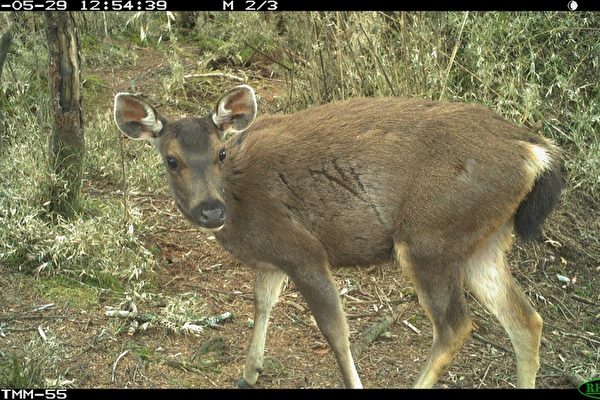The Forestry and Nature Conservation Bureau of the Republic of China’s Ministry of Agriculture has announced the results of long-term monitoring of wildlife in state-owned forest areas through the use of automated cameras. Over the past eight years, they have accumulated over 480,000 photos, with the top ten most frequently captured animals including Formosan serow, Formosan rock macaque, and ferret badger.
According to a press release from the Forestry Conservation Bureau, starting from September 2015, infrared automated cameras were set up in state-owned forest areas to monitor wildlife. In recent years, professors from National Pingtung University of Science and Technology, Associate Professor Liu Jian-Nan from National Chiayi University, and other institutions have been commissioned to assist in expanding the camera setups at various elevations. There are currently 387 monitoring points that can track the population changes of medium and large-sized wild mammals over the long term.
The setup and data download of this long-term wildlife monitoring system are carried out by forest rangers from various branches of the Forestry Conservation Bureau. Operations, from camera setup and battery replacement to image data retrieval and animal identification, follow standardized procedures to minimize disturbances to wildlife. It is through years of data accumulation and comprehensive analysis that significant concrete results have been obtained.
From September 2015 to July 2023, the accumulated image records have exceeded over 124 million hours, capturing approximately 480,000 valid photos. The number of photos captured for each species reflects their relative abundance. The top ten most captured species are Formosan serow (287,957 photos), Formosan rock macaque (54,359 photos), ferret badger (48,389 photos), squirrel (18,470 photos), white-bellied musk deer (15,731 photos), crab-eating mongoose (12,334 photos), Formosan sika deer (12,146 photos), wild goat (10,371 photos), wild boar (6,700 photos), and masked palm civet (6,264 photos).
The Forestry Conservation Bureau further explains that since the automated cameras mainly capture ground-active animals, the relative abundance of Formosan rock macaques and squirrels may be underestimated.
The relative abundance of wildlife and the long-term trends of their populations are crucial for conservation decisions. For instance, based on wildlife resource assessments in 2019, Formosan serow, Formosan rock macaque, and white-bellied musk deer were reclassified from conservation species to general wildlife. Concerns were raised by the public about the future protection needs of these species due to potential over-hunting.
According to the results of long-term monitoring, the Formosan serow’s OI value (relative frequency) increased from 19.4 in 2019 to 31.4 in 2022. Similarly, the OI value for Formosan rock macaques increased from 3.85 to 5.43, and for white-bellied musk deer from 1.26 to 1.33 during the same period, indicating a healthy population status for these three species.
Furthermore, despite the Formosan sika deer being currently classified as a conservation species and a traditional hunting species of indigenous people, its OI value increased from 0.61 in 2015 to 1.79 in 2022, showing a yearly rise in population richness. The percentage of camera locations featuring Formosan sika deer also increased from 1.63% to 30.66% during the same period.
The Forestry Conservation Bureau notes that while Formosan sika deer used to mainly inhabit the high-altitude regions of the Central Mountain Range, they have gradually spread to lower elevations in recent years. The most noticeable increase in population richness is observed in the 1,000 to 2,000 meters above sea level range, with the lowest recorded distribution at an altitude of 135 meters in Shalin District, Kaohsiung City.
Automated camera monitoring not only provides insights into species distribution and population trends but also offers information on animal behavior and physiological cycles. For example, Formosan sika deer are active throughout the day, with peak activity observed between 4-6 am. Spring is the season when male deer grow antlers, followed by shedding the velvet to enter the hard antler phase, which is also the breeding season for sika deer, with fawns often appearing during the hottest summer weather.
Moreover, there have been increasing records of sightings of Formosan black bears, with the OI value of population abundance rising annually. Multiple instances of photos capturing bear cubs or mother bears carrying cubs demonstrate a wider distribution range and positive breeding conditions for the species.
The Forestry Conservation Bureau has announced plans to significantly increase the number of automated camera locations starting this year, expanding wildlife monitoring from state-owned forest areas to low mountainous and plain areas nationwide. This expansion aims to capture more wildlife population trends across the country accurately and develop precise wildlife management policies.

